Organizational Design and Management Report for Readycash
VerifiedAdded on 2019/10/18
|5
|1959
|155
Report
AI Summary
This report provides an organizational design for Readycash, focusing on key management theories and practical applications. It begins with an overview of the company, then delves into essential resources like human, financial, and physical assets, emphasizing the need for effective management. The report proposes a matrix organizational structure to enhance efficiency, transparency, and information flow, and discusses the importance of e-commerce integration. It suggests New Zealand as a strategic location for expansion and outlines monitoring and control mechanisms. The report highlights the benefits of the matrix structure in terms of employee retention, rapid information flow, and effective resource utilization. The conclusion summarizes the key points, emphasizing resource optimization and the alignment of organizational structure with growth plans. References to management theories are included to support the analysis.
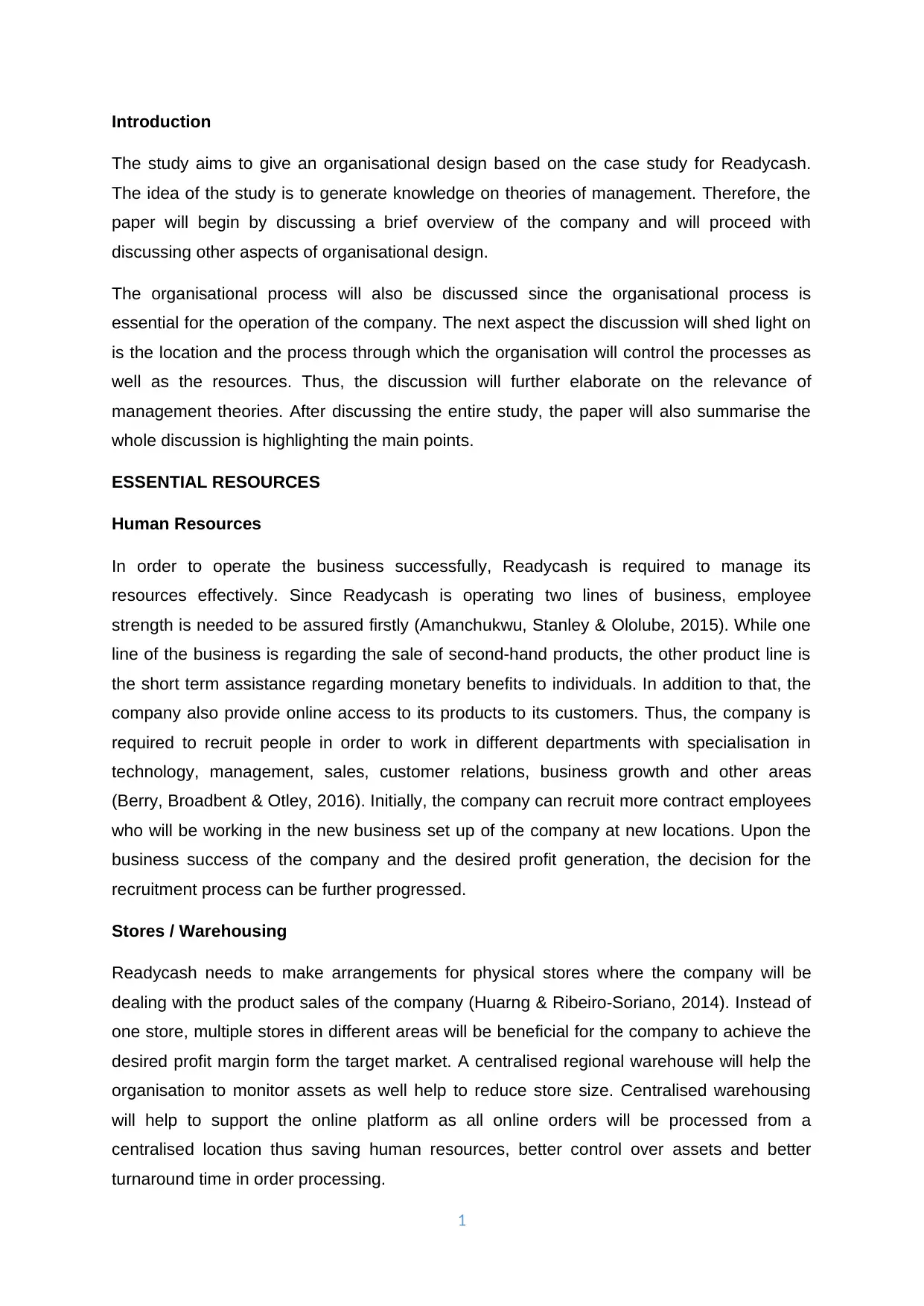
Introduction
The study aims to give an organisational design based on the case study for Readycash.
The idea of the study is to generate knowledge on theories of management. Therefore, the
paper will begin by discussing a brief overview of the company and will proceed with
discussing other aspects of organisational design.
The organisational process will also be discussed since the organisational process is
essential for the operation of the company. The next aspect the discussion will shed light on
is the location and the process through which the organisation will control the processes as
well as the resources. Thus, the discussion will further elaborate on the relevance of
management theories. After discussing the entire study, the paper will also summarise the
whole discussion is highlighting the main points.
ESSENTIAL RESOURCES
Human Resources
In order to operate the business successfully, Readycash is required to manage its
resources effectively. Since Readycash is operating two lines of business, employee
strength is needed to be assured firstly (Amanchukwu, Stanley & Ololube, 2015). While one
line of the business is regarding the sale of second-hand products, the other product line is
the short term assistance regarding monetary benefits to individuals. In addition to that, the
company also provide online access to its products to its customers. Thus, the company is
required to recruit people in order to work in different departments with specialisation in
technology, management, sales, customer relations, business growth and other areas
(Berry, Broadbent & Otley, 2016). Initially, the company can recruit more contract employees
who will be working in the new business set up of the company at new locations. Upon the
business success of the company and the desired profit generation, the decision for the
recruitment process can be further progressed.
Stores / Warehousing
Readycash needs to make arrangements for physical stores where the company will be
dealing with the product sales of the company (Huarng & Ribeiro-Soriano, 2014). Instead of
one store, multiple stores in different areas will be beneficial for the company to achieve the
desired profit margin form the target market. A centralised regional warehouse will help the
organisation to monitor assets as well help to reduce store size. Centralised warehousing
will help to support the online platform as all online orders will be processed from a
centralised location thus saving human resources, better control over assets and better
turnaround time in order processing.
1
The study aims to give an organisational design based on the case study for Readycash.
The idea of the study is to generate knowledge on theories of management. Therefore, the
paper will begin by discussing a brief overview of the company and will proceed with
discussing other aspects of organisational design.
The organisational process will also be discussed since the organisational process is
essential for the operation of the company. The next aspect the discussion will shed light on
is the location and the process through which the organisation will control the processes as
well as the resources. Thus, the discussion will further elaborate on the relevance of
management theories. After discussing the entire study, the paper will also summarise the
whole discussion is highlighting the main points.
ESSENTIAL RESOURCES
Human Resources
In order to operate the business successfully, Readycash is required to manage its
resources effectively. Since Readycash is operating two lines of business, employee
strength is needed to be assured firstly (Amanchukwu, Stanley & Ololube, 2015). While one
line of the business is regarding the sale of second-hand products, the other product line is
the short term assistance regarding monetary benefits to individuals. In addition to that, the
company also provide online access to its products to its customers. Thus, the company is
required to recruit people in order to work in different departments with specialisation in
technology, management, sales, customer relations, business growth and other areas
(Berry, Broadbent & Otley, 2016). Initially, the company can recruit more contract employees
who will be working in the new business set up of the company at new locations. Upon the
business success of the company and the desired profit generation, the decision for the
recruitment process can be further progressed.
Stores / Warehousing
Readycash needs to make arrangements for physical stores where the company will be
dealing with the product sales of the company (Huarng & Ribeiro-Soriano, 2014). Instead of
one store, multiple stores in different areas will be beneficial for the company to achieve the
desired profit margin form the target market. A centralised regional warehouse will help the
organisation to monitor assets as well help to reduce store size. Centralised warehousing
will help to support the online platform as all online orders will be processed from a
centralised location thus saving human resources, better control over assets and better
turnaround time in order processing.
1
Paraphrase This Document
Need a fresh take? Get an instant paraphrase of this document with our AI Paraphraser
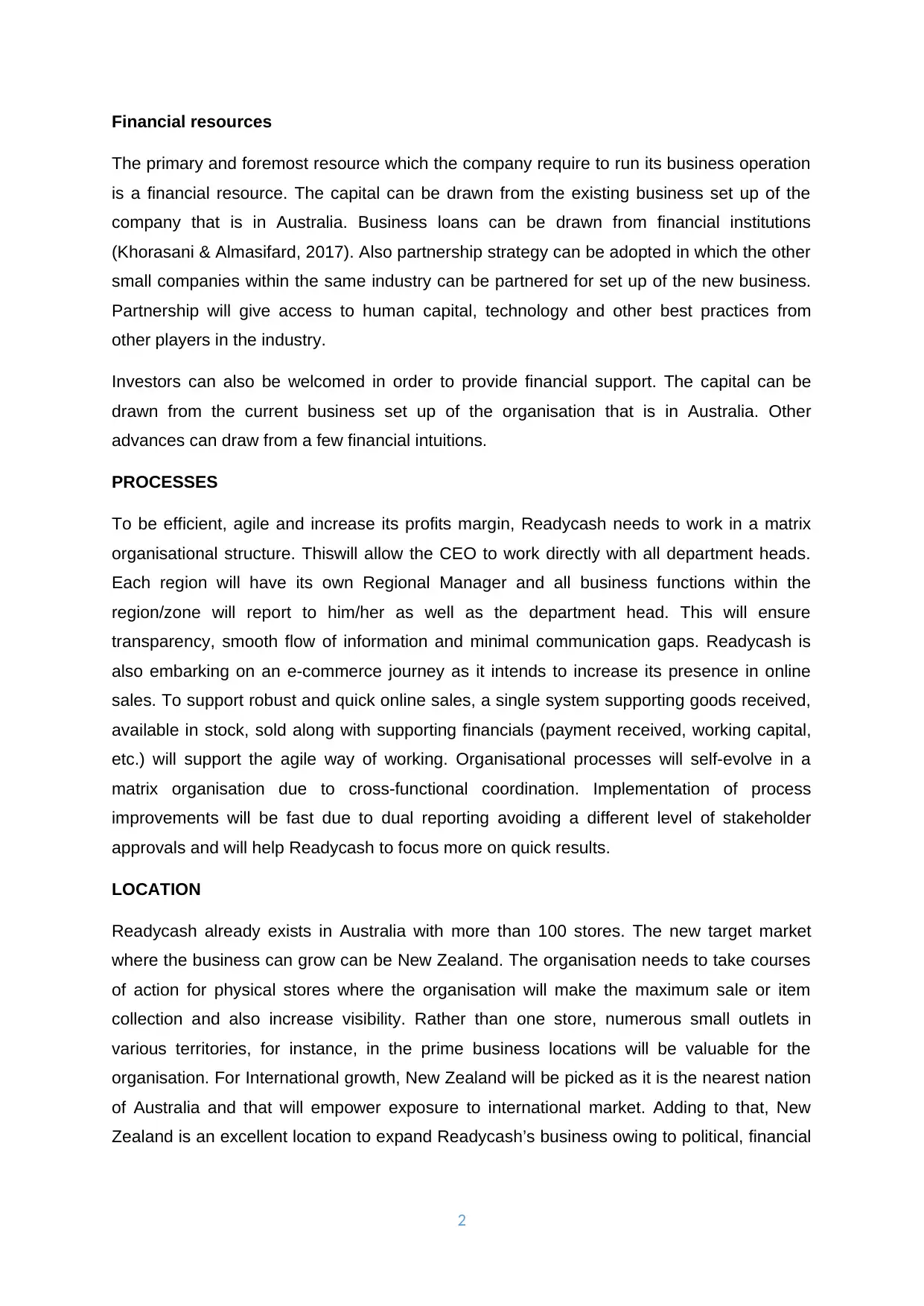
Financial resources
The primary and foremost resource which the company require to run its business operation
is a financial resource. The capital can be drawn from the existing business set up of the
company that is in Australia. Business loans can be drawn from financial institutions
(Khorasani & Almasifard, 2017). Also partnership strategy can be adopted in which the other
small companies within the same industry can be partnered for set up of the new business.
Partnership will give access to human capital, technology and other best practices from
other players in the industry.
Investors can also be welcomed in order to provide financial support. The capital can be
drawn from the current business set up of the organisation that is in Australia. Other
advances can draw from a few financial intuitions.
PROCESSES
To be efficient, agile and increase its profits margin, Readycash needs to work in a matrix
organisational structure. Thiswill allow the CEO to work directly with all department heads.
Each region will have its own Regional Manager and all business functions within the
region/zone will report to him/her as well as the department head. This will ensure
transparency, smooth flow of information and minimal communication gaps. Readycash is
also embarking on an e-commerce journey as it intends to increase its presence in online
sales. To support robust and quick online sales, a single system supporting goods received,
available in stock, sold along with supporting financials (payment received, working capital,
etc.) will support the agile way of working. Organisational processes will self-evolve in a
matrix organisation due to cross-functional coordination. Implementation of process
improvements will be fast due to dual reporting avoiding a different level of stakeholder
approvals and will help Readycash to focus more on quick results.
LOCATION
Readycash already exists in Australia with more than 100 stores. The new target market
where the business can grow can be New Zealand. The organisation needs to take courses
of action for physical stores where the organisation will make the maximum sale or item
collection and also increase visibility. Rather than one store, numerous small outlets in
various territories, for instance, in the prime business locations will be valuable for the
organisation. For International growth, New Zealand will be picked as it is the nearest nation
of Australia and that will empower exposure to international market. Adding to that, New
Zealand is an excellent location to expand Readycash’s business owing to political, financial
2
The primary and foremost resource which the company require to run its business operation
is a financial resource. The capital can be drawn from the existing business set up of the
company that is in Australia. Business loans can be drawn from financial institutions
(Khorasani & Almasifard, 2017). Also partnership strategy can be adopted in which the other
small companies within the same industry can be partnered for set up of the new business.
Partnership will give access to human capital, technology and other best practices from
other players in the industry.
Investors can also be welcomed in order to provide financial support. The capital can be
drawn from the current business set up of the organisation that is in Australia. Other
advances can draw from a few financial intuitions.
PROCESSES
To be efficient, agile and increase its profits margin, Readycash needs to work in a matrix
organisational structure. Thiswill allow the CEO to work directly with all department heads.
Each region will have its own Regional Manager and all business functions within the
region/zone will report to him/her as well as the department head. This will ensure
transparency, smooth flow of information and minimal communication gaps. Readycash is
also embarking on an e-commerce journey as it intends to increase its presence in online
sales. To support robust and quick online sales, a single system supporting goods received,
available in stock, sold along with supporting financials (payment received, working capital,
etc.) will support the agile way of working. Organisational processes will self-evolve in a
matrix organisation due to cross-functional coordination. Implementation of process
improvements will be fast due to dual reporting avoiding a different level of stakeholder
approvals and will help Readycash to focus more on quick results.
LOCATION
Readycash already exists in Australia with more than 100 stores. The new target market
where the business can grow can be New Zealand. The organisation needs to take courses
of action for physical stores where the organisation will make the maximum sale or item
collection and also increase visibility. Rather than one store, numerous small outlets in
various territories, for instance, in the prime business locations will be valuable for the
organisation. For International growth, New Zealand will be picked as it is the nearest nation
of Australia and that will empower exposure to international market. Adding to that, New
Zealand is an excellent location to expand Readycash’s business owing to political, financial
2
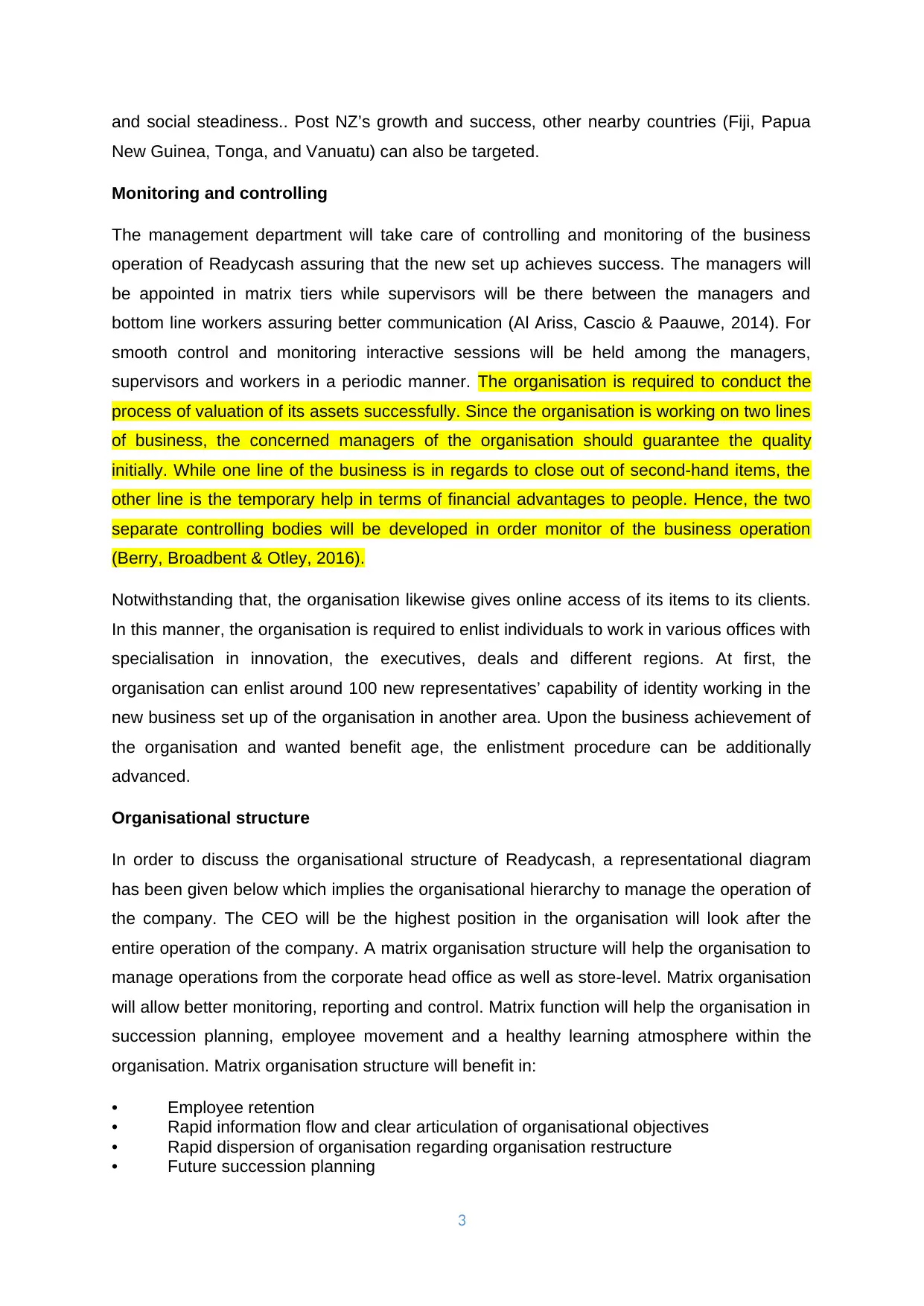
and social steadiness.. Post NZ’s growth and success, other nearby countries (Fiji, Papua
New Guinea, Tonga, and Vanuatu) can also be targeted.
Monitoring and controlling
The management department will take care of controlling and monitoring of the business
operation of Readycash assuring that the new set up achieves success. The managers will
be appointed in matrix tiers while supervisors will be there between the managers and
bottom line workers assuring better communication (Al Ariss, Cascio & Paauwe, 2014). For
smooth control and monitoring interactive sessions will be held among the managers,
supervisors and workers in a periodic manner. The organisation is required to conduct the
process of valuation of its assets successfully. Since the organisation is working on two lines
of business, the concerned managers of the organisation should guarantee the quality
initially. While one line of the business is in regards to close out of second-hand items, the
other line is the temporary help in terms of financial advantages to people. Hence, the two
separate controlling bodies will be developed in order monitor of the business operation
(Berry, Broadbent & Otley, 2016).
Notwithstanding that, the organisation likewise gives online access of its items to its clients.
In this manner, the organisation is required to enlist individuals to work in various offices with
specialisation in innovation, the executives, deals and different regions. At first, the
organisation can enlist around 100 new representatives’ capability of identity working in the
new business set up of the organisation in another area. Upon the business achievement of
the organisation and wanted benefit age, the enlistment procedure can be additionally
advanced.
Organisational structure
In order to discuss the organisational structure of Readycash, a representational diagram
has been given below which implies the organisational hierarchy to manage the operation of
the company. The CEO will be the highest position in the organisation will look after the
entire operation of the company. A matrix organisation structure will help the organisation to
manage operations from the corporate head office as well as store-level. Matrix organisation
will allow better monitoring, reporting and control. Matrix function will help the organisation in
succession planning, employee movement and a healthy learning atmosphere within the
organisation. Matrix organisation structure will benefit in:
• Employee retention
• Rapid information flow and clear articulation of organisational objectives
• Rapid dispersion of organisation regarding organisation restructure
• Future succession planning
3
New Guinea, Tonga, and Vanuatu) can also be targeted.
Monitoring and controlling
The management department will take care of controlling and monitoring of the business
operation of Readycash assuring that the new set up achieves success. The managers will
be appointed in matrix tiers while supervisors will be there between the managers and
bottom line workers assuring better communication (Al Ariss, Cascio & Paauwe, 2014). For
smooth control and monitoring interactive sessions will be held among the managers,
supervisors and workers in a periodic manner. The organisation is required to conduct the
process of valuation of its assets successfully. Since the organisation is working on two lines
of business, the concerned managers of the organisation should guarantee the quality
initially. While one line of the business is in regards to close out of second-hand items, the
other line is the temporary help in terms of financial advantages to people. Hence, the two
separate controlling bodies will be developed in order monitor of the business operation
(Berry, Broadbent & Otley, 2016).
Notwithstanding that, the organisation likewise gives online access of its items to its clients.
In this manner, the organisation is required to enlist individuals to work in various offices with
specialisation in innovation, the executives, deals and different regions. At first, the
organisation can enlist around 100 new representatives’ capability of identity working in the
new business set up of the organisation in another area. Upon the business achievement of
the organisation and wanted benefit age, the enlistment procedure can be additionally
advanced.
Organisational structure
In order to discuss the organisational structure of Readycash, a representational diagram
has been given below which implies the organisational hierarchy to manage the operation of
the company. The CEO will be the highest position in the organisation will look after the
entire operation of the company. A matrix organisation structure will help the organisation to
manage operations from the corporate head office as well as store-level. Matrix organisation
will allow better monitoring, reporting and control. Matrix function will help the organisation in
succession planning, employee movement and a healthy learning atmosphere within the
organisation. Matrix organisation structure will benefit in:
• Employee retention
• Rapid information flow and clear articulation of organisational objectives
• Rapid dispersion of organisation regarding organisation restructure
• Future succession planning
3
⊘ This is a preview!⊘
Do you want full access?
Subscribe today to unlock all pages.

Trusted by 1+ million students worldwide
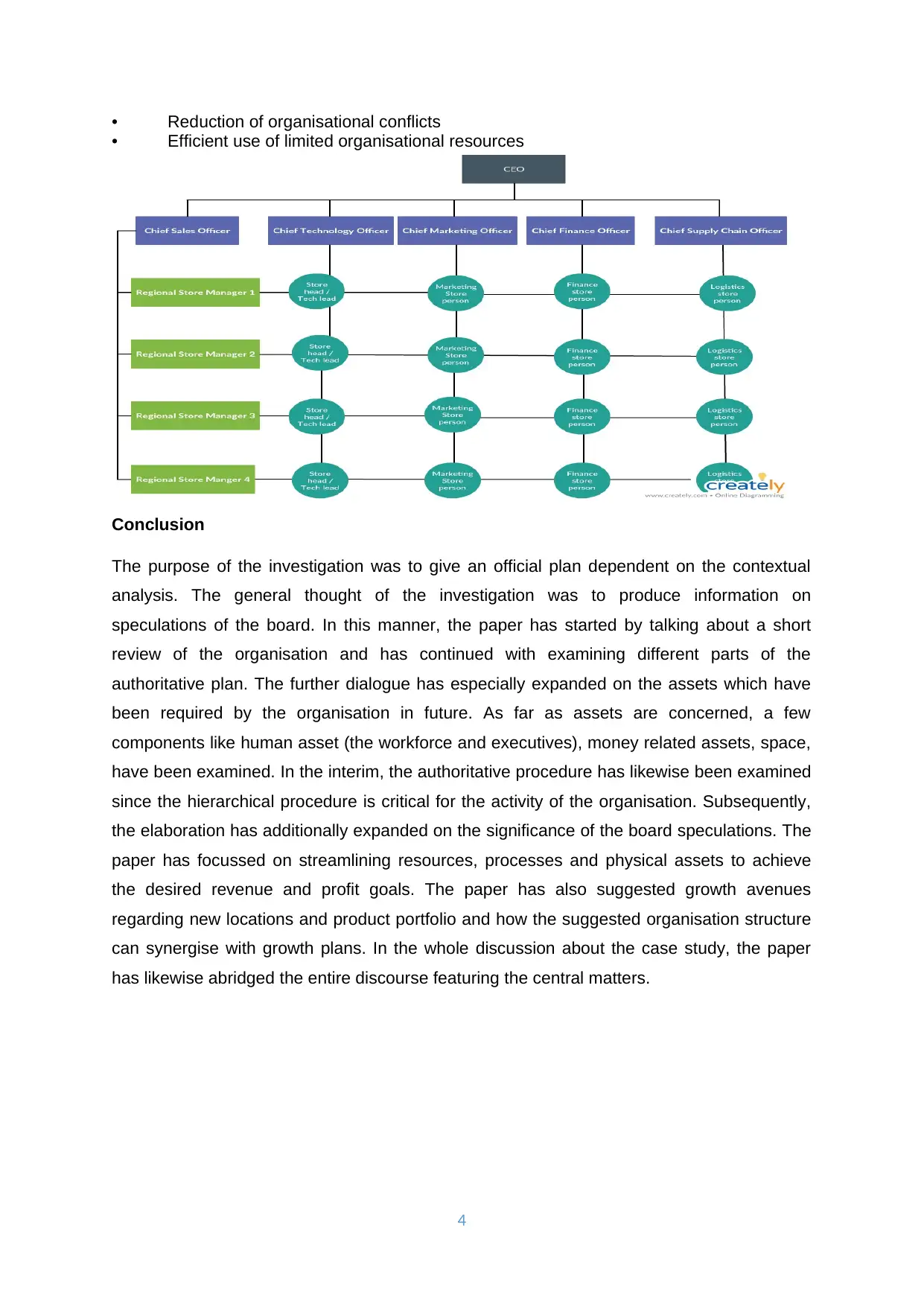
• Reduction of organisational conflicts
• Efficient use of limited organisational resources
Conclusion
The purpose of the investigation was to give an official plan dependent on the contextual
analysis. The general thought of the investigation was to produce information on
speculations of the board. In this manner, the paper has started by talking about a short
review of the organisation and has continued with examining different parts of the
authoritative plan. The further dialogue has especially expanded on the assets which have
been required by the organisation in future. As far as assets are concerned, a few
components like human asset (the workforce and executives), money related assets, space,
have been examined. In the interim, the authoritative procedure has likewise been examined
since the hierarchical procedure is critical for the activity of the organisation. Subsequently,
the elaboration has additionally expanded on the significance of the board speculations. The
paper has focussed on streamlining resources, processes and physical assets to achieve
the desired revenue and profit goals. The paper has also suggested growth avenues
regarding new locations and product portfolio and how the suggested organisation structure
can synergise with growth plans. In the whole discussion about the case study, the paper
has likewise abridged the entire discourse featuring the central matters.
4
• Efficient use of limited organisational resources
Conclusion
The purpose of the investigation was to give an official plan dependent on the contextual
analysis. The general thought of the investigation was to produce information on
speculations of the board. In this manner, the paper has started by talking about a short
review of the organisation and has continued with examining different parts of the
authoritative plan. The further dialogue has especially expanded on the assets which have
been required by the organisation in future. As far as assets are concerned, a few
components like human asset (the workforce and executives), money related assets, space,
have been examined. In the interim, the authoritative procedure has likewise been examined
since the hierarchical procedure is critical for the activity of the organisation. Subsequently,
the elaboration has additionally expanded on the significance of the board speculations. The
paper has focussed on streamlining resources, processes and physical assets to achieve
the desired revenue and profit goals. The paper has also suggested growth avenues
regarding new locations and product portfolio and how the suggested organisation structure
can synergise with growth plans. In the whole discussion about the case study, the paper
has likewise abridged the entire discourse featuring the central matters.
4
Paraphrase This Document
Need a fresh take? Get an instant paraphrase of this document with our AI Paraphraser
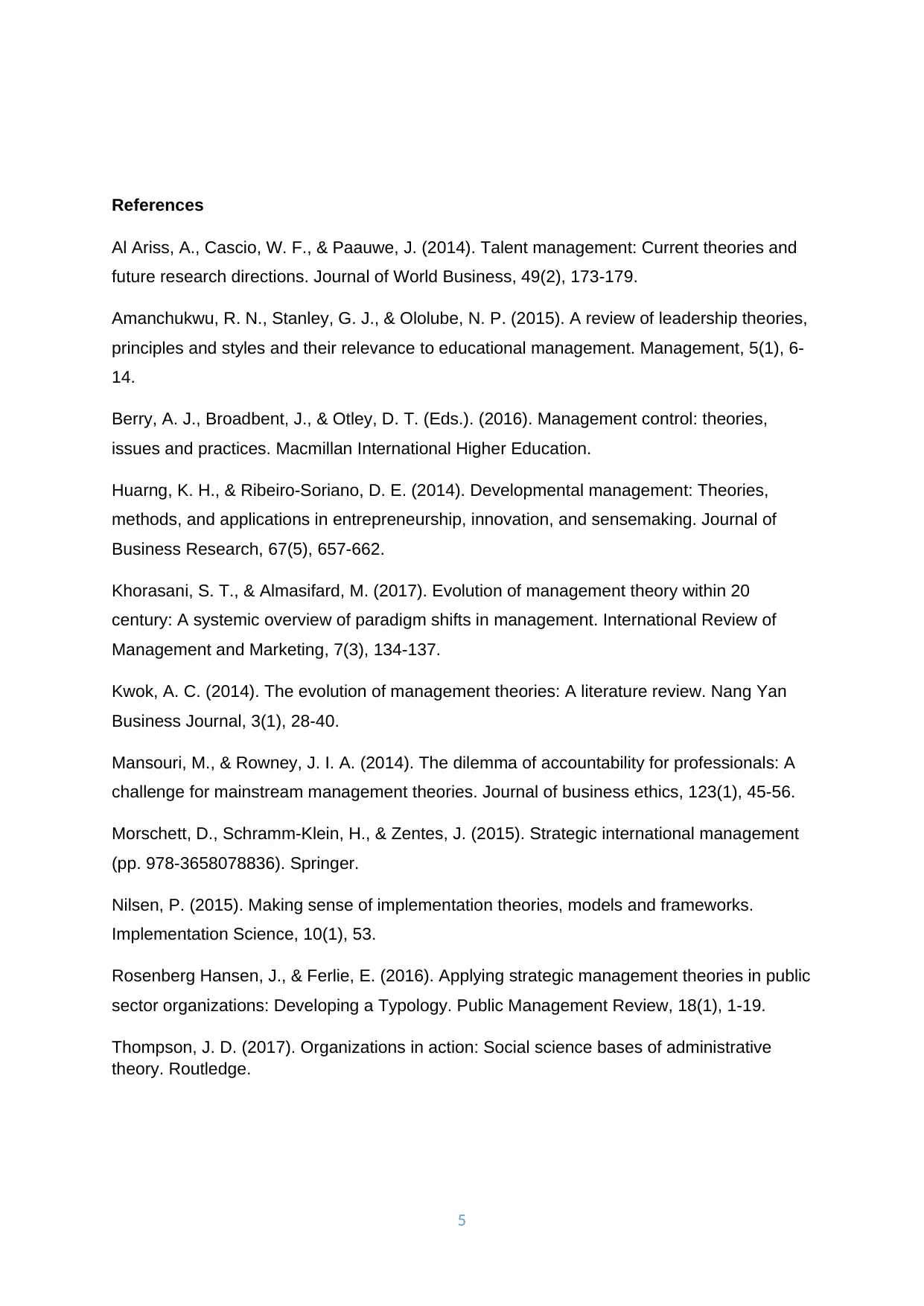
References
Al Ariss, A., Cascio, W. F., & Paauwe, J. (2014). Talent management: Current theories and
future research directions. Journal of World Business, 49(2), 173-179.
Amanchukwu, R. N., Stanley, G. J., & Ololube, N. P. (2015). A review of leadership theories,
principles and styles and their relevance to educational management. Management, 5(1), 6-
14.
Berry, A. J., Broadbent, J., & Otley, D. T. (Eds.). (2016). Management control: theories,
issues and practices. Macmillan International Higher Education.
Huarng, K. H., & Ribeiro-Soriano, D. E. (2014). Developmental management: Theories,
methods, and applications in entrepreneurship, innovation, and sensemaking. Journal of
Business Research, 67(5), 657-662.
Khorasani, S. T., & Almasifard, M. (2017). Evolution of management theory within 20
century: A systemic overview of paradigm shifts in management. International Review of
Management and Marketing, 7(3), 134-137.
Kwok, A. C. (2014). The evolution of management theories: A literature review. Nang Yan
Business Journal, 3(1), 28-40.
Mansouri, M., & Rowney, J. I. A. (2014). The dilemma of accountability for professionals: A
challenge for mainstream management theories. Journal of business ethics, 123(1), 45-56.
Morschett, D., Schramm-Klein, H., & Zentes, J. (2015). Strategic international management
(pp. 978-3658078836). Springer.
Nilsen, P. (2015). Making sense of implementation theories, models and frameworks.
Implementation Science, 10(1), 53.
Rosenberg Hansen, J., & Ferlie, E. (2016). Applying strategic management theories in public
sector organizations: Developing a Typology. Public Management Review, 18(1), 1-19.
Thompson, J. D. (2017). Organizations in action: Social science bases of administrative
theory. Routledge.
5
Al Ariss, A., Cascio, W. F., & Paauwe, J. (2014). Talent management: Current theories and
future research directions. Journal of World Business, 49(2), 173-179.
Amanchukwu, R. N., Stanley, G. J., & Ololube, N. P. (2015). A review of leadership theories,
principles and styles and their relevance to educational management. Management, 5(1), 6-
14.
Berry, A. J., Broadbent, J., & Otley, D. T. (Eds.). (2016). Management control: theories,
issues and practices. Macmillan International Higher Education.
Huarng, K. H., & Ribeiro-Soriano, D. E. (2014). Developmental management: Theories,
methods, and applications in entrepreneurship, innovation, and sensemaking. Journal of
Business Research, 67(5), 657-662.
Khorasani, S. T., & Almasifard, M. (2017). Evolution of management theory within 20
century: A systemic overview of paradigm shifts in management. International Review of
Management and Marketing, 7(3), 134-137.
Kwok, A. C. (2014). The evolution of management theories: A literature review. Nang Yan
Business Journal, 3(1), 28-40.
Mansouri, M., & Rowney, J. I. A. (2014). The dilemma of accountability for professionals: A
challenge for mainstream management theories. Journal of business ethics, 123(1), 45-56.
Morschett, D., Schramm-Klein, H., & Zentes, J. (2015). Strategic international management
(pp. 978-3658078836). Springer.
Nilsen, P. (2015). Making sense of implementation theories, models and frameworks.
Implementation Science, 10(1), 53.
Rosenberg Hansen, J., & Ferlie, E. (2016). Applying strategic management theories in public
sector organizations: Developing a Typology. Public Management Review, 18(1), 1-19.
Thompson, J. D. (2017). Organizations in action: Social science bases of administrative
theory. Routledge.
5
1 out of 5
Related Documents
Your All-in-One AI-Powered Toolkit for Academic Success.
+13062052269
info@desklib.com
Available 24*7 on WhatsApp / Email
![[object Object]](/_next/static/media/star-bottom.7253800d.svg)
Unlock your academic potential
Copyright © 2020–2025 A2Z Services. All Rights Reserved. Developed and managed by ZUCOL.





